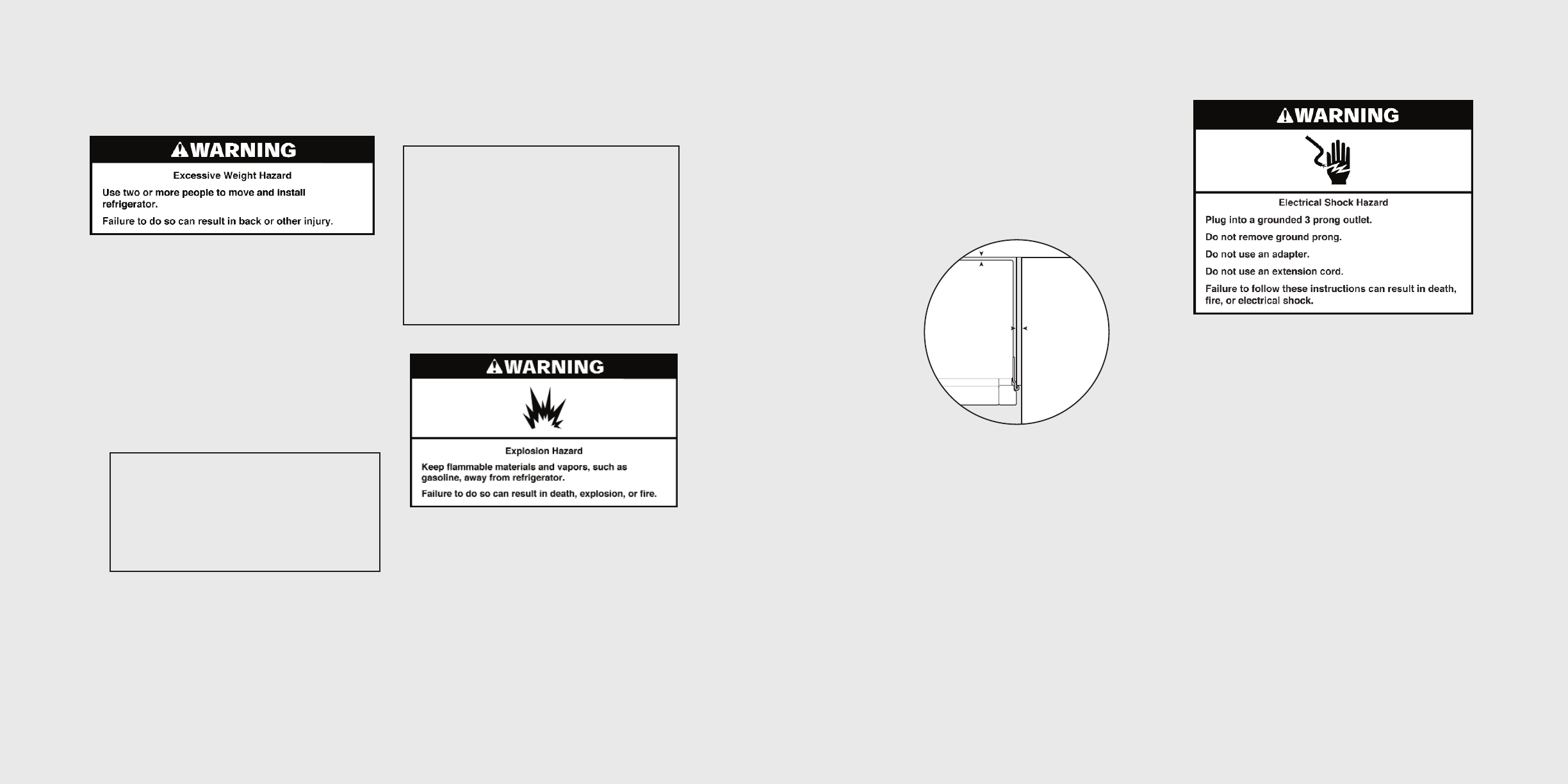
General Information
11
To ensure proper ventilation for your refrigerator,
allow for a 1/2" (1.25 cm) space on each side and
at the top. Allow 1/2" (1.3 cm) of space behind
the refrigerator. If your refrigerator has an ice
maker, allow extra space at the back for the water
line connections. When installing your refrigerator
next to a fixed wall, leave a 2-3/4" (7.0 cm)
minimum space between the refrigerator and wall
to allow the door to swing open.
Moving Unit
• DO NOT transport the refrigerator on its side. If
an upright position is not possible, lay the
refrigerator on its back. Allow refrigerator to sit
upright for approximately 30 minutes before
plugging it in to assure oil returns to the
compressor. Plugging the refrigerator in
immediately may cause damage to internal
parts.
• Use an appliance dolly when moving
refrigerator. ALWAYS truck refrigerator from its
side or back - NOT from its front.
• Cover outside finish of refrigerator during
transport by wrapping cabinet in blankets
or inserting padding between the refrigerator
and dolly.
• Secure refrigerator to dolly firmly with straps or
bungee cords. Thread straps through handles
when possible. DO NOT overtighten.
Overtightening restraints may dent or damage
outside finish.
Electrical Requirements
Before you move your refrigerator to its final
location, it is important to make sure you have
the proper electrical connection.
Recommended Grounding Method
A 115 Volt, 60 Hz., AC only 15- or 20-amp fused,
grounded electrical supply is required. It is
recommended that a separate circuit serving only
your refrigerator be provided. Use an outlet that
cannot be turned off by a switch. DO NOT use an
extension cord.
Note: Before performing any type of installation,
cleaning, or removing a light bulb, turn the
cooling OFF. Disconnect the refrigerator from the
electrical source. When you are finished,
reconnect the refrigerator to the electrical source
and turn cooling on.
1/2”
(1.27 cm)
Door
Wall
Overhead View
2-3/4”
(6.99 cm)
Wall
10
General Information
Your refrigerator was packed carefully for
shipment. Remove and discard all packaging and
tape. DO NOT remove the model/serial number
label.
Remove the Packaging
• Remove tape and glue residue from surfaces
before turning on the refrigerator. Rub a small
amount of liquid dish soap over the adhesive
with your fingers. Wipe with warm water and
dry.
• DO NOT use sharp instruments, rubbing
alcohol, flammable fluids, or abrasive cleaners
to remove tape or glue. These products can
damage the surface of your refrigerator. For
more information,
see “Refrigerator Safety.”
• Dispose of/recycle all packaging materials.
When moving your refrigerator:
Your refrigerator is heavy. When moving the
refrigerator for cleaning or service, be sure to
protect the floor. Always pull the refrigerator
straight out when moving it. DO NOT wiggle or
“walk” the refrigerator when trying to move, as
floor damage could occur.
Clean Before Using
After you remove all of the packaging materials,
clean the inside of your refrigerator before using
it.
See the cleaning instructions in “Use and
Care Guide.”
Important information to know about glass
shelves and covers:
DO NOT clean glass shelves or covers with warm
water when they are cold. Shelves and covers
may break if exposed to sudden temperature
changes or impact, such as bumping. For your
protection, tempered glass is designed to shatter
into many small, pebble-size pieces. This is
normal. Glass shelves and covers are heavy. Use
special care when removing them to avoid impact
from dropping.
Location Requirements
• DO NOT install refrigerator near oven, radiator
or other heat sources. If not possible, shield
refrigerator material.
• DO NOT install where the temperature falls
below 55°F (13°C) or rises above 110°F (43°C).
Malfunctions can occur at these temperatures.
• Refrigerator is designed for indoor household
application only.












